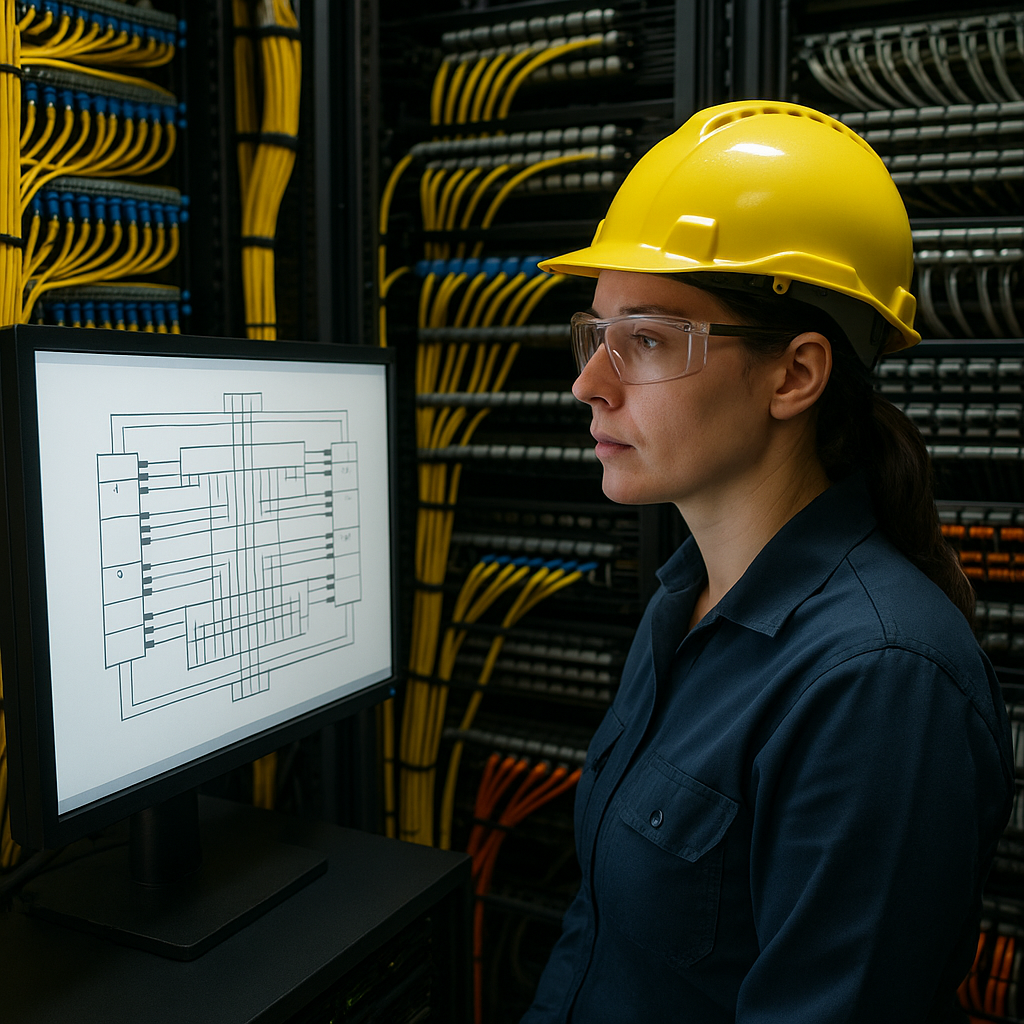Structured Cabling Color Codes: What Each Cable Color Means
In a structured cabling system, knowing what each cable does shouldn't take guesswork. With the right color code standard in place, a technician can...
4 min read
 Kevin Murphy
:
Aug 12, 2025 3:02:50 PM
Kevin Murphy
:
Aug 12, 2025 3:02:50 PM
What’s the cost of a messy cable setup? When cables are crammed, mislabeled, or routed poorly, systems overheat, repairs take longer, and downtime becomes inevitable.
According to the Uptime Institute’s 2023 Outage Analysis, human error contributes to nearly 80% of data center failures. Many of these incidents are linked to avoidable design flaws, including cable routing. Worse, 70% of outages now cost over $100,000, with a quarter exceeding $1 million.
Poor cable management increases risk, leads to downtime, and drives up operational costs. A well-managed cable pathway supports airflow, keeps electrical cables and data lines separated, and allows room for future expansion. This guide covers best practices for cable management, routing, and pathway selection to help keep your infrastructure reliable, organized, and easy to maintain.
Every cable routing job starts with a solid layout. Before running any wire, sketch out the full pathway. Look at how the room is built, where server racks and network switches will go, and how cables will move through ceiling trays or floor conduits. Think beyond what’s needed today. Good cable pathway planning allows for future expansion, new equipment, and increased bandwidth. Oversized trays or modular ladder racks make it easier to scale without ripping out your setup. A clear plan saves time, prevents clutter, and avoids costly rerouting later.
Different cable pathways serve different purposes, and choosing the wrong one can lead to poor performance or safety issues. Cable trays are ideal for long horizontal runs with multiple cables. They offer airflow, easy access, and support for heavy wiring. Ladder racks are common in data centers for overhead routing and are strong enough to handle large cable bundles.
Refer to ANSI/TIA‑942 standards for more details on cable tray loading and airflow clearance.
Always size the pathway to fit the number of cables and plan for 30–50% future growth to avoid overcrowding and reduced airflow.
Safe cable routing prevents electrical interference, signal loss, and physical hazards. Always separate electrical cables from data lines to reduce electromagnetic interference (EMI), especially near power-hungry equipment like HVAC units, fluorescent lighting, and building electrical systems. Keep copper and fiber cables in different pathways to avoid signal interference and simplify troubleshooting.
Avoid routing wires across high-traffic areas where they can become a tripping risk. Use cable holders or surface-mounted raceways to guide cables safely. Secure everything tightly with proper support systems to prevent sagging, damage, or accidental unplugging.
Poor cable management blocks airflow and causes equipment to overheat. Tightly packed wires in cable trays, raceways, or enclosures trap heat and reduce system reliability. This not only leads to high temperatures but also impacts the performance of electrical equipment and network hardware. Make sure cables and wires are spaced out evenly and routed using proper cable guides. Avoid stacking, overcrowding, or laying bundles over fan vents. Use blanking panels in server rooms to control airflow direction and improve cooling efficiency. Maintaining airflow and cooling protects your investment and keeps everything running.
Cables aren’t made to stretch or twist. Using cables that are too short creates strain on ports and can lead to broken connectors. Extra slack, on the other hand, adds clutter, obstructs airflow, and puts unnecessary weight on cable trays and supports. Avoid sharp bends, kinks, or any routing that violates the recommended cable bend diameter. Use cable holders, spools, and sweeping turns to maintain structure. Be mindful of power cable positioning and avoid mixing them with data cables, which can cause damage and interference. Every cable should be routed to allow room for cooling, maintenance, and future expansion.
Labeling is critical for fast repairs, smooth upgrades, and easy troubleshooting. Each cable should have clear marking on both ends, including cable type, enclosure number, port, and destination. Use durable, legible tags and color-coded cable ties to distinguish between power cables, horizontal cable runs, and fiber lines. Maintain updated cable management documentation that tracks wire pathways, connector types, and patch panel locations. This helps avoid confusion, reduces downtime, and supports easy accessibility when expanding or modifying your data center layout.
The right tools and materials are essential for safe, long-lasting cable management. Use Velcro or hook-and-loop ties instead of zip ties to avoid over-tightening and damaging cables. Choose strong, lightweight trays and cable holders designed for your specific environment. Install surge-protected PDUs to safely power network equipment and reduce the risk of electrical damage.
Always follow ANSI/TIA-942 standards for data center cabling, and make sure everything is grounded and bonded correctly. Local safety codes are just as important as compliance protects your infrastructure and keeps your team safe.
Cable routing directly affects system performance, uptime, and safety. Poor layout choices lead to overheating, EMI issues, and long hours wasted during maintenance. Whether you’re managing a data center or building out a small server room, clean and efficient cable pathways reduce risks, cut energy costs, and make daily operations smoother. Getting it right from the start saves time, money, and effort—especially when your network grows.
With more than 25 years of experience, over 30 technical certifications, and a track record of over 1,000 successful projects, Turn-key Technologies (TTI) delivers structured cabling systems built for real-world demands. From high-capacity data centers to school networks, TTI designs, installs, and supports systems that stay reliable under pressure. See how we've done it in our case studies.
Explore our full Structured Cabling Guide to get installation tips, standards, and insights from the field. Ready to upgrade your infrastructure? Learn more about our Structured Cabling Installation Services and find out how TTI can help you build smarter, cleaner, and safer cable pathways. You can also explore how we integrate cable pathway planning into broader network strategies in our Data Center Infrastructure Services.

Kevin has been with Turn-key Technologies since 2012, overseeing cabling teams and managing projects from concept to completion. With deep expertise in structured cabling installations—including fiber optics, Cat5/5e/6/6a, and coax systems—he works closely with clients and engineers to deliver reliable, high-quality solutions on time and on budget.
Certifications:
NJ Division of Consumer Affairs
• Uniform & Construction Code
• Residential Fire Alarm Systems
• Smoke Detection Systems
• NJ Barrier Free Subcode
• ADA & Licensing Law
NYS Licenses
• Security & Fire Alarm License
• Electrical Training Center Fire Alarm Certification
BICSI & Technical
• Designing for PoE Lighting
• Fiber Optic & Connector Termination
• Firestop 101
Other Certifications
• OSHA 30-Hour Construction Safety
• Verkada Certified Engineer
• Avigilon Access Control Manager 6

In a structured cabling system, knowing what each cable does shouldn't take guesswork. With the right color code standard in place, a technician can...

Fiber optic cables are the invisible highways of our digital world, carrying massive amounts of data at the speed of light. But what happens when you...

5 min read
The modern commercial building is no longer a passive structure of steel and glass; it's a dynamic, intelligent environment. Smart building...